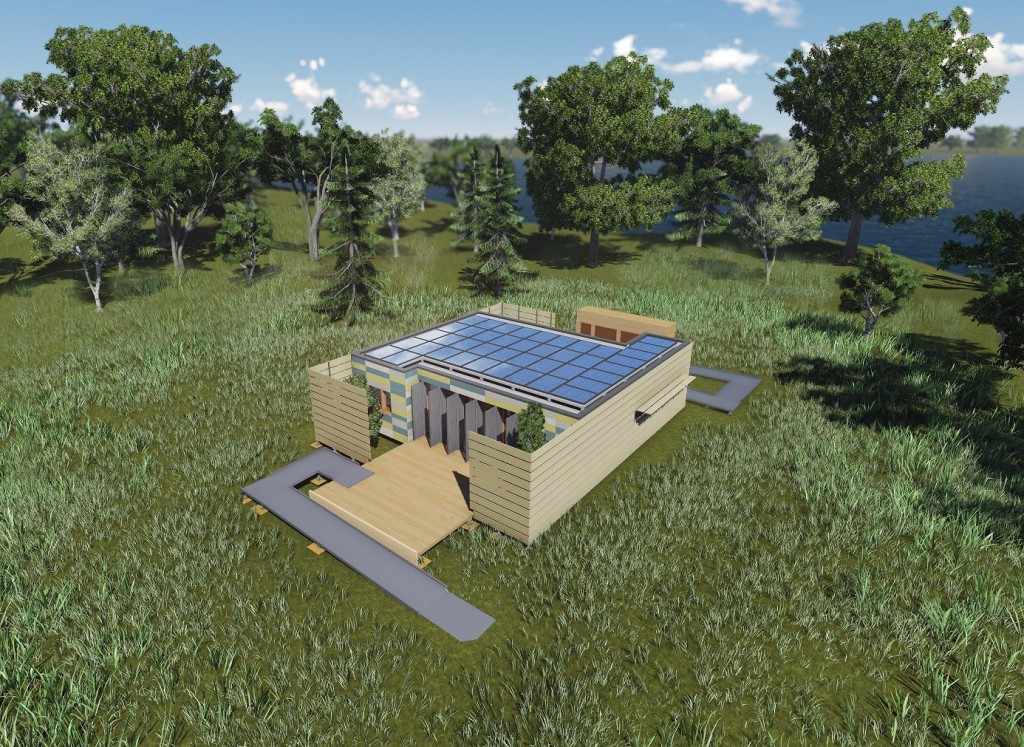Crowder College and Drury University Aim To Withstand Tornadoes With ShelteR3
Tuesday, May 12, 2015By Ernie Tucker
Tornadoes are common in Missouri. But the twister that hit Joplin, Missouri, on May 22, 2011, provided special motivation for the Crowder College and Drury University team’s U.S. Department of Energy Solar Decathlon 2015 project. That monster storm, packing winds greater than 200 mph, killed 161 people and caused billions of dollars in damage near Crowder College’s campus, which is only 80 miles from Drury University in Springfield, Missouri. Although tornadoes are common, natives don’t take their destructive power lightly.
“Part of what engaged so many students at our schools is the fact that we are attacking a real-world problem that has directly affected the families of some of us involved. That acts as a real motivator,” says decathlete Evan Melgren, a Springfield native who graduated from Drury in December.

Members of the Crowder College and Drury University team gather at the Orange County Great Park on Jan. 9. (Credit: Carol Laurie/U.S. Department of Energy Solar Decathlon)
“We wanted to reflect the design imperative we learned about in the wake of the Joplin tornado,” says Melgren.
The team seeks “to lessen the damage next time”—a certainty in a state that averages 27 tornadoes yearly.
Early on, an advisor who had been part of the Joplin recovery effort explained an approach of a trio of actions: response, recovery, and resistance to future storms. Says Melgren, “We latched on to those three ‘R words,’ and came up with ShelteR3,” which is pronounced “shelter cubed.”
The team tested various materials and researched the effects of high winds on structures.
“We are all students working through these issues for the first time,” says Melgren. “But that’s what this opportunity affords students to do. We are confident that the house can withstand some pretty nasty blows.”

ShelteR3, the project from Crowder College and Drury University, is designed to resist a storm like the tornado that struck Joplin, Missouri, in 2011. (Courtesy of the Solar Decathlon 2015 Crowder College and Drury University team)
A key to the team’s approach is layers of resistance—starting with an aluminum and composite fence, the first layer of defense against storm shrapnel. The exterior of the house itself is made of a fiber cement cladding, and underneath that is a sheet of polycarbonate along with a strong frame made of thicker materials than normal. Steel rods, hidden in the walls, attach the floor more securely to the ceiling to further strengthen the structure against wind pressure. The team added storm doors and windows with coverings to resist a storm’s fury. Parapets on the roof protect the solar panels, lessening the chances of them blowing away.
The project is not only intended to resist a storm. The team also believes this type of house could aid storm recovery efforts. Emergency crews could quickly bring one in to provide resilient off-grid shelter with minimal assembly—something lacking in devastated Joplin.
Crowder, which competed in Solar Decathlon 2002 and 2005, boasts strong construction management and solar engineering programs.
“They reached out to us [Drury] to help with architectural design and communication,” Melgren says, and now the two institutions have about 40 active decathletes.
Melgren says a spring build session was not only fun but also “a real team-bonding experience, kneeling shoulder-to-shoulder with teammates hammering nails.”
After the Solar Decathlon, the team expects that ShelteR3 will return to the Drury campus for about a year and then go to the Crowder campus to join the two previous Solar Decathlon houses. And although nobody can say for certain how the structure would fare against a massive tornado like the one that struck Joplin, Melgren says, “Our improvements to the design of the house are definitely major steps in the right direction.”
Ernie Tucker is a member of the U.S. Department of Energy Solar Decathlon communications team.
Tags: Crowder/Drury, Solar Decathlon, Solar Decathlon 2015, Teams
